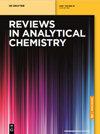A simple salicylaldehyde-bearing pyrazine as a turn-on fluorescent chemosensor for Al3+ and Zn2+ recognition and its applications
IF 3.8
3区 化学
Q2 CHEMISTRY, ANALYTICAL
引用次数: 1
Abstract
Abstract A simple fluorescent chemosensor, 5-(diethylamino)-2-((2-(pyrazin-2-yl) hydrazono)methyl)phenol, has been synthesized by Schiff-base condensation reaction. The chemosensor exhibited highly selective and sensitive “off-on” fluorescent responses toward Al3+ and Zn2+ but the signal of fluorescence emission varies. The detection limits were found to be 2.33 × 10−7 M for Al3+ and 1.68 × 10−7 M for Zn2+, respectively. The binding mechanisms between chemosensor and Al3+ or Zn2+ ions were supported by Job′s, 1H NMR, Fourier transform infrared spectra, and MS experiments. The sensing behavior was also studied with molecular logic functions of OR, AND, and NOT gates. In addition, the chemosensor was able to detect Al3+ and Zn2+ by producing distinct color changes observed by the naked eye on sensor-coated swabs. Moreover, the chemosensor was successfully applied to effectively detect Al3+ and Zn2+ in actual water and drug samples. Graphical abstract一种简单水杨醛吡嗪作为Al3+和Zn2+识别的荧光化学传感器及其应用
摘要采用希夫碱缩合反应合成了一种简单的荧光化学传感器5-(二乙基氨基)-2-((2-(吡嗪-2-基)腙)甲基)苯酚。该化学传感器对Al3+和Zn2+具有高选择性和高灵敏度的“开关”荧光响应,但荧光发射信号不同。Al3+和Zn2+的检出限分别为2.33 × 10−7 M和1.68 × 10−7 M。Job’s、1H NMR、傅里叶变换红外光谱和质谱实验支持了化学传感器与Al3+或Zn2+离子的结合机制。利用或门、与门和非门的分子逻辑函数对传感行为进行了研究。此外,该化学传感器能够通过在涂有传感器的拭子上产生肉眼观察到的明显颜色变化来检测Al3+和Zn2+。此外,该化学传感器成功地应用于实际水和药物样品中Al3+和Zn2+的有效检测。图形抽象
本文章由计算机程序翻译,如有差异,请以英文原文为准。
求助全文
约1分钟内获得全文
求助全文
来源期刊

Reviews in Analytical Chemistry
化学-分析化学
CiteScore
7.50
自引率
0.00%
发文量
15
审稿时长
>12 weeks
期刊介绍:
Reviews in Analytical Chemistry publishes authoritative reviews by leading experts in the dynamic field of chemical analysis. The subjects can encompass all branches of modern analytical chemistry such as spectroscopy, chromatography, mass spectrometry, electrochemistry and trace analysis and their applications to areas such as environmental control, pharmaceutical industry, automation and other relevant areas. Review articles bring the expert up to date in a concise manner and provide researchers an overview of new techniques and methods.
 求助内容:
求助内容: 应助结果提醒方式:
应助结果提醒方式:


